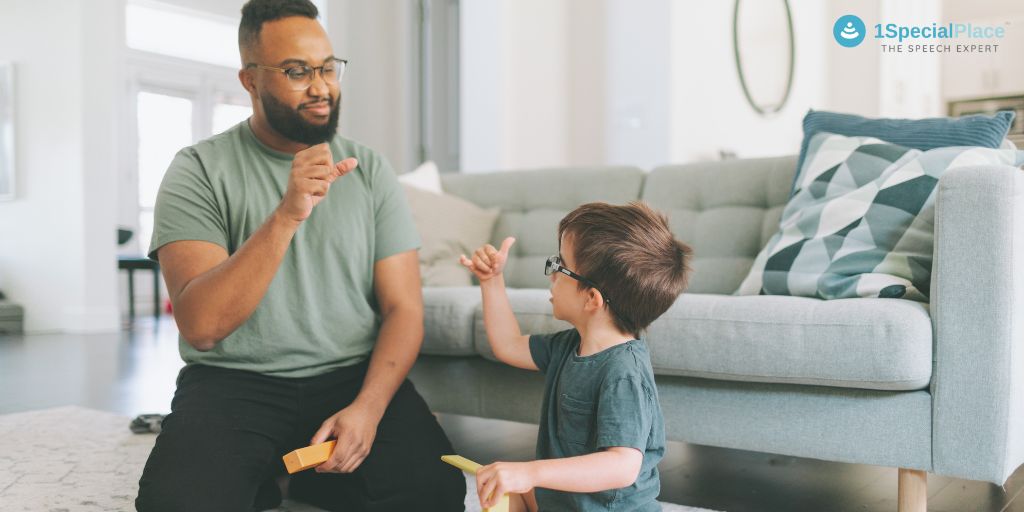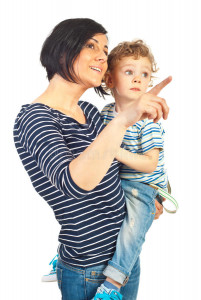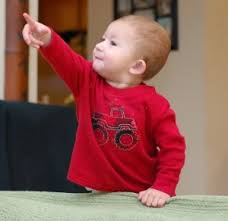
Pointing: An Important Tool for Communication
Pointing: An Important Tool for Communication
Pointing to communicate – Experts say that a person’s communication is not solely through ‘Speech’ or spoken words. A large chunk of it is via non-verbal modalities. Non-verbal communication can include, the use of body language (which also includes pointing), the tone of voice, proximity/distance between speakers, facial expression, and others.
Pointing is one of the ways in which the body can be used to communicate information and desires. The skill of pointing is an important developmental milestone that is learnt between the stages of babbling (i.e. the first few sounds the child makes) and saying their first word. As the research base about pointing keeps growing, it is becoming clearer that pointing is a precursor for speech and language skills. It also allows us to understand a child’s later language skills and learning.
Is Pointing important?
Pointing proves to be a good indicator of a child’s vocabulary and later language skills. Since it is the first communicative gesture a child makes, it also allows the child to begin interactions with the world around him. This is very important since it enables the child to draw others’ attention to them, interact with a listener/adult, get into a conversation and learn that they can influence the outcome of the interaction.
Pointing to communicate
 What are the stages of Pointing?
What are the stages of Pointing?
The skill of pointing is developmental and gets refined as the child grows. 7 or 8 months upwards, a child begins to understand and later use pointing for a variety of ‘communicative functions’.
A child will begin to develop the skill of ‘watching’ others point (by a speaker/adult). Later they will begin to point. At first, they may use whole-hand pointing, and later it will advance to index-finger pointing. A child should use index finger pointing (to communicate a desire or need) by 18 months. Only with time, will a child learn to point to items that were present in the environment (but are not there anymore) or to items that are at a distance.
Why does a child Point?
Pointing is used for diverse purposes or ‘communicative functions’. A child may use pointing to-
- Tell a need or express a desire; so as to tell ‘I want.. / Give me….’
- Express himself or label an item; to communicate ‘This is….’
- Share an experience; in a way of saying ‘Look at me / Look at …’
- Draw attention to something; such as to communicate ‘Oh oh / Oh no!’
- Talk about something that is no longer present, which may mean, ‘Oh! Where is ….?’
What skills should I child have to achieve Pointing?
Although the skill of pointing may seem quite straightforward and simple, it, however, isn’t so. A child can learn to point only with an amalgamation of several important developmental skills. These include – motor skills (fine and gross), joint attention, eye-hand coordination, eye contact (especially during shared attention), awareness of other people, language skills, object permanence (when communicant the absence of an item) and understanding of cause and effect. A child will slowly develop each of these skills from birth.
Research indicates that the ability to – wave bye, clap and raise hands to be lifted up – are all precursors to using the skill of ‘pointing’. These specific skills allow a child to build on imitation skills, eye-hand coordination, ability to request for need, amongst others.
When should you be concerned about the skill of Pointing?
Between 12 and 18 months, a child should develop the skill of pointing. Look out for the following subtle skills and seek professional assistance if your child is not able to do several of the following by the age of 18 months:
- Looks towards what you are pointing at (which may be nearby and of interest)
- Attempts whole-hand pointing
- Points to an item of desire or want
- Claps hands (can be in imitation)
- Waves bye (can be in imitation)
- Looks for objects that are hidden (the child must be familiar with the items)
- Looks at items that are named (the child must be familiar with the items)
Will pointing be different in a child with developmental delays?
Each child with developmental delays will come with their unique skills set. An assessment will help define the child’s ability. Pointing, in these children may be as follows:
- Few children with delays may not be able to point. This may be due to several reasons, ranging from poor motor skills, lack of eye-hand coordination, inability to imitate the action, vision issues etc. Instead few children may learn to fulfill their needs or desires by themselves (by taking the item they want on their own) or on the other hand, have communication breakdowns (which may lead to meltdowns).
- Some may learn to point, as they develop the precursor skills for it.
- At times, children with developmental delays will only be able to use ‘whole-hand’ pointing to indicate their needs. Their skill does not refine to Index finger pointing until taught.
- Other children may learn to point in a different way – such as with the whole body or with their face/eyes.
- Children with developmental delays may not be able to use pointing for several communicative functions. It may be limited to pointing for needs only. They have to be taught to use it for other functions too.
Despite the level of pointing skill a child has, a therapist can assist in developing the needed abilities to encourage pointing. This is an important milestone to get the child to communicate with his / her environment.
It is wise to watch the development of the skill of Pointing closely over the first couple of years for all children. Such a crucial tool for communication and an important indicator for later language development must be given importance! If there is any deviance or delay in this ability, a professional’s assistance should be sought.
***
Subscribe with us to read more about How to build the skill of Pointing.
****
If you wish to know more about Speech Therapy, kindly contact us at info@1specialplace.com
For more ideas check out our other blogs https://1specialplace.com/news/
- What is speech therapy and what Speech Therapist Do? - December 22, 2022
- 5 Simple Ideas to Make Flashcards Fun - June 28, 2018
- Should I use ‘NO’ with my child? - June 24, 2018


Leave a Comment
(0 Comments)